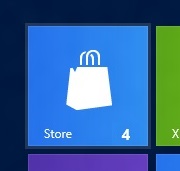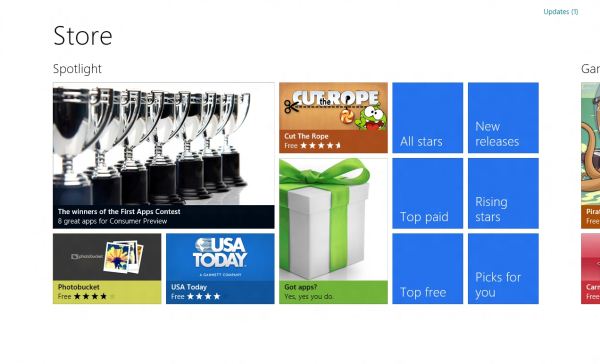In-Depth with the Windows 8 Consumer Preview
by Andrew Cunningham, Ryan Smith, Kristian Vättö & Jarred Walton on March 9, 2012 10:30 AM EST- Posted in
- Microsoft
- Operating Systems
- Windows
- Windows 8
Now that we’ve covered the bulk of Windows’ new UI elements, it’s time to get down to some individual apps, and there’s no app more important to Windows 8’s success than the Windows Store.
Unfortunately, at this point it's a bit difficult to tell how the store is going to work out—it seems like one of the less-finished apps provided in the Consumer Preview. There are basic categories for games, social apps, music apps, and a few others, but aside from the basic Search functionality (which is accessed from the Charms menu), there's just a sprawling "top free" list and a lot of scrolling. The Windows Store definitely shouldn't be judged on this early iteration, but a lack of polish (unlike in other Metro screens, more tiles don't show up when more screen space is available—if you look at the Store on a screen with a vertical resolution of much more than 768 pixels, you'll just see a big unused area of white space below the Store tiles) and missing features make it a rough demo at best.
As in both the Apple and Android app stores, you’ll need to sign in with a Windows Live ID to download anything from the Windows Store. If you used your Windows Live ID to create an account during Windows Setup, the OS can download and install apps without asking you for any extra information, but you can still use your Live ID even if you chose to create a local account. Once you’ve purchased an app, you’ll be able to download that app to any Windows 8 or Windows on ARM device you’ve signed into with your Windows Live ID.

All of the preview apps in the Windows Store are currently offered free of charge, but in the RTM version of the store developers will be able to offer both “Buy” and “Try” buttons for apps with demos—apps can have either timed or feature-limited demos available. Unlocking the full version of the app requires no separate download, and all of your saved data from the demo is still available. Info pages for apps also list compatible processor architectures—x86, x64, and ARM.

As seen above, when updates are available a small number will appear on the Windows Store tile. Entering the Store and clicking the "Updates" link in the upper right-hand corner of the screen will present a list of available updates, which you can install individually or all at once.
Apps submitted to the Windows Store have to make it through Microsoft’s approval process, which looks to be a more developer-friendly version of Apple's system: Windows 8 will be a curated platform, which should help curb some of the malware problems that Android is having. However, criteria for approval are clearly laid out, and developers whose apps are rejected will be given feedback on what changes they'll need to make to get approved. Microsoft is also updating its development tools to help guide developers through all the steps of the certification process.
For both advertisements and in-app purchases, Microsoft offers its own platforms but does not mandate their use. If a newspaper or magazine publisher has an existing database of its users and a pre-existing authentication system, that publisher is free to continue using them in its app. Apple began mandating the use of its systems for in-app purchases last year, meaning that all in-app purchases on iOS are subject to Apple’s 70/30 revenue split, and Google may be moving to prohibit third-party in-app purchases even as you read this.
Lastly, let’s assuage the fears of enterprise administrators: via group policies and PowerShell scripts, domain administrators can both permit and deny access to the Windows Store and to individual apps, and can also deploy Metro apps directly to PCs without using the Windows Store at all. This opens the door to volume-licensed apps, and will help IT admins to provide a consistent set of programs and features across different Windows 8 systems.
Whether the Windows Store will succeed remains to be seen—things like app discovery and user interface are important, but in the end the Windows Store is just a portal that will live or die on the quality and quantity of its apps. Those that are available are in a preview state, and while we’ll look at a few of the core Metro apps later on in this article, it doesn’t make a lot of sense to to do in-depth reviews of apps that are in beta-at-best states.
I will lay out one major concern up-front: while apps like Evernote and Cut the Rope do well on smartphones and tablets, I wonder how well more full-featured programs like Photoshop and Office will scale to Metro with their functionality intact. The Windows Store and its WinRT APIs are Microsoft’s future, but take this as a case in point: Microsoft is going to be shipping a copy of Office with every Windows on ARM tablet, but rather than providing Metro versions of Word, Office, PowerPoint, and OneNote to show developers how it’s done, it’s providing copies of those programs that will run only in the desktop environment, and it’s doing this in spite of the fact that no other developers will be able to use the Windows desktop on Windows-powered ARM tablets.
That doesn’t necessarily mean that Office apps will never get Metro styling, and it doesn’t mean that developers aren’t going to make some nice, feature-rich Metro apps, but Microsoft’s refusal to eat its own dog food in this case makes me a little nervous about the kind of programs we’ll end up seeing in Metro.











286 Comments
View All Comments
WPLJ42 - Friday, March 9, 2012 - link
The price was right on an HP AIO with an ULV CPU. Even with a 1.6 GHz CPU, the fan runs too much. About W8. Both the Developer and Consumer versions crashed and burned. After a few days, my PC went into a constant loop of rebooting. With the Consumer version, I was careful not to let Windows Update install any hardware drivers. I was using a dual boot with Windows 7. With both W8DP and W8CP, if I shut the computer down with Windows 8, it would boot itself in the dark of night. I am not an IT guy, just a run of the mill user. I had no issues with Windows 7 Beta, but it was running on an iMac with either VirtualBox or BootCamp, and it had to be the 32-bit version. I would like to know if my probably is an AMD thing, or HP, or if it is just me.Hulk - Friday, March 9, 2012 - link
As the author posted the Windows XP OS was getting long in tooth for me as I wanted to upgrade to 64bit OS and apps. Now that I'm there with Windows 7 I have absolutely no reason to upgrade to Windows 8. Actually since I'm sure we'll still be using 64bit applications in Windows 9 it might be a VERY long time before I move from Windows 7. I stayed with XP 9 years and if we were still 32 bit I have a feeling I'd still be using it.Good luck MS. But I'm fairly confident you're going down the wrong path on this one. 99.9% of desktop PC's are not touch screens. It doesn't make sense to alienate those users to "future-proof" yourself.
I bet they will reverse course on this in Windows 9.
hrmes09 - Friday, March 9, 2012 - link
Having used Windows 8 preview has made me so angry that I registered to Anandtech just to post this!I can't believe that MS is trying to shove all this down our throat!
Metro looks childish on a desktop computer and feels awkward. It's also the least intuitive gui that I have ever used!
If they continue down that road Windows 8 is going to be Microsoft's Itanium.
glugglug - Friday, March 9, 2012 - link
The Storage Spaces feature is truly awesome for us.hechacker1 - Friday, March 9, 2012 - link
I think that's probably my favorite Windows 8 feature.I just wonder how it compares to Intel raid, or other hardware raid. Frankly, Intel RAID is ok, but RAID5 write performance drops off a cliff.
Benchmarks Anandtech?
What I don't like is that it's probably impossible to access this from any other operating system if you happen to dual boot. At least Intel's and most other RAID5 implementations are accessible.
Oh, and the NTFS deduplication sound interesting too. Although you don't get to use it on ReFS AFAIK.
rburnham - Friday, March 9, 2012 - link
Great article! My only disappointment was not seeing the new OS installed on a Windows tablet, like the Acer Iconia.Zaranthos - Friday, March 9, 2012 - link
Where's my regular start menu? Quick launch (yeah I hate pinned icons)? Regular desktop icons? I spent a couple hours using Windows hate (8), went to bed mad, got up mad, told some of my friends how much Windows 8 sucked, and haven't used it since. My keyboard and mouse serve a purpose and Metro made them seem nearly useless. Windows 8 might be my new Vista/ME. I'd throw all the other improvements into the garbage can if they're tied to Metro.dchinu - Friday, March 9, 2012 - link
Its so dmn dumb argument "In fact they’re not disabling anything that hasn’t already been disabled on most competing tablets."Its like saying I am not the only one look at him, he's too a bedwetter
fisherg - Friday, March 9, 2012 - link
I believe it takes 3 mouse clicks to shut down Win 8. How many for Win 7? My XP machine is 3hrmes09 - Friday, March 9, 2012 - link
2 mouse clicks for Win 7. Also fewer miles moving the mouse around...